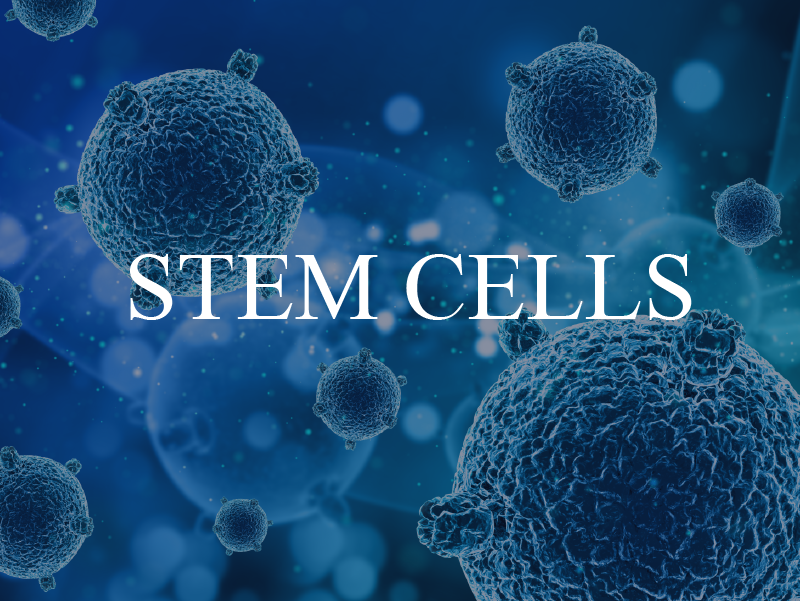Stem Cells
Stem cells that lead to innovations that have the potential to restore and repair, resulting in good health longevity.

What are Stem Cells?
Stem cells are a special type of cell in living organisms that can be found during growth. It can divide and increase the number of cells without limit and can change into almost every type of cell in the body, such as skin, brain, heart, muscle, and blood cells. It has an important role in dividing, multiplying and changing into different types of cells, to replace damaged cells in the body.
Benefits of Stem Cells

Health
-
Physical Recovery
For more than 20 years, the medical community has been highly excited about the idea of using stem cells in “Medicine to rehabilitate degenerative conditions (regenerative medicine)” which follows the success of organ transplants to treat chronic organ-disabled diseases, such as kidney failure, liver failure, and congenital heart disease. The main limitation or obstacle is the shortage of organs from donors. Therefore, stem cells are a promising source of precursor cells that can be developed into different types of tissues and organs to repair or rebuild those organs. Along with restoring various systems in the body from the deterioration that has occurred and treat degenerative diseases such as cardiovascular disease, Alzheimer's, and cancer. Stem cells communicate between cells and allow cells to work with better efficiency, including reducing inflammation in the body.
-
Rehabilitation of Various Diseases
Diseases that medical professionals accept that stem cells can be used to restore include more than 85 diseases caused by abnormalities in the blood system and others. This includes all types of blood cancers such as leukaemia, anaemia, thalassemia, bone marrow, cell abnormalities, immune deficiency disease, diseases caused by abnormalities in the production of red blood cells and diseases from metabolic disorders, etc and more diseases are in the process of clinical research. It is believed that in the future, diseases that are difficult to cure or cannot be cured, such as liver and heart diseases, congenital diabetes and cancer, may be cured using stem cells.

Beauty
-
Revitalize and nourish the skin
Helps restore and repair damaged skin cells making the skin look healthy, youthful and more radiant.
-
Reduce wrinkles
Stimulates the creation of collagen and elastin, which are the main components of the skin, making the skin strong and wrinkleless.
-
Reduce blemishes and dark spots
Reduces the production of black melanin and stimulates the production of white melanin, making the skin look even and youthful.
Where do Stem Cells come from?

Fats
From a fat called Adipose-Derived Stem Cells (ADSC) which are stem cells within our body that can develop and grow into “tissue cells” in various areas of the body. It is one of the most widely known stem cells for its use in fat injections, stem cells for skin rejuvenation, and beauty.
Blood
From a blood called Hematopoietic Stem Cell (HSC) which is a blood-forming stem cell that floats in small quantities in the body’s circulatory system at all times. The body receives cytokines that stimulate bone marrow function, such as G-CSF which stimulates the creation of stem cells that the body produces itself.
By blood stem cell transplant , which will be enough if a bone marrow transplant is needed to treat a blood disease or cancer such as lymphoma, immune system disorders, multiple myeloma, etc.
New medical indications include autoimmune diseases such as multiple sclerosis, MS, SLE, rheumatoid arthritis, etc.


เลือด
จากเลือดเรียกว่า Hematopoietic Stem Cell (HSC) คือเซลล์ต้นกำเนิดสร้างเม็ดเลือดที่ล่องลอยอยู่ในระบบไหลเวียนโลหิตในร่างกายปริมาณน้อยๆตลอดเวลา แต่เมื่อร่างกายได้รับไซโตไคน์ที่กระตุ้นการทำงานของไขกระดูก เช่น จีซีเอสเอฟ G-CSF (เป็นตัวกระตุ้นการสร้างเซลล์ต้นกำเนิดที่ร่างกายผลิตได้เอง) หรือการฟื้นตัวของไขกระดูกภายหลังจากการรับยาเคมีบำบัด จะทำให้เซลล์ต้นกำเนิดสร้างเม็ดเลือดในกระแสโลหิตเพิ่มจำนวนอย่างรวดเร็ว การปลูกถ่ายเซลล์ต้นกำเนิดที่เก็บจากกระแสโลหิตมีแนวโน้มที่จะติดเร็วกว่าการใช้เซลล์ต้นกำเนิดจากไขกระดูก นั่นอาจเป็นเพราะมีเซลล์ต้นกำเนิดสร้างเม็ดเลือดที่โตเต็มที่มากกว่า เมื่อพูดถึง“การปลูกถ่ายเซลล์ต้นกำเนิด” โดยปกติจะหมายถึง การปลูกถ่ายเซลล์ต้นกำเนิดจากกระแสโลหิต แหล่งที่อยู่ของเซลล์ต้นกำเนิดในธรรมชาติคือไขกระดูก แต่เราสามารถทำให้เซลล์ต้นกำเนิดออกจากไขกระดูกเข้ากระแสโลหิตซึ่งการเก็บเซลล์ต้นกำเนิดจะทำได้ง่ายกว่าเซลล์ต้นกำเนิดเหล่านี้จะถูกแช่เยือกแข็งทั้งแบบถุงและแบบหลอดสำหรับความจำเป็นในอนาคต ซึ่งจะมีจำนวนมากพอถ้าจำเป็นต้องปลูกถ่ายไขกระดูกรักษาโรคเลือดหรือโรคมะเร็ง เช่น มะเร็งต่อมน้ำเหลือง ความผิดปกติของระบบภูมิคุ้มกัน โรคมัลติเพิล มัยอิโลมา เป็นต้น (2) ข้อบ่งชี้ใหม่ๆทางการแพทย์ ได้แก่ กลุ่มโรคแพ้ภูมิตัวเอง เช่นโรคปลอกประสาทเสื่อมเอ็มเอส โรคเอสแอลอี โรครูมาตอยด์ ฯลฯ ผลการศึกษาวิจัยเร็วๆนี้สนับสนุนการใช้ในภาวะสมองบาดเจ็บทั้งในเด็กและผู้ใหญ่แต่เวลาที่เหมาะสมในการใช้สั้นทำให้การเก็บเซลล์ล่วงหน้าเป็นสิ่งสำคัญ

Tissues
From a tissue called Mesenchymal Stem Cell (MSC) which is a stem cell that communicates between cells, allowing them to work with better efficiency, repair, restore, and reduce inflammation in the body. MSC cells cannot replace umbilical cord blood in bone marrow transplants, but they can be used in regenerative medicine, beauty enhancement, anti-ageing, degenerative conditions of joints such as osteoarthritis, and ligament injuries. There are many studies in the field of skin allergy; autoimmune diseases, diabetes, Parkinson’s and Alzheimer’s diseases, sunburn and scars, etc.

Cultivation of Stem Cells
Autologous Stem Cell
Collection and cultivation of stem cells are taken from the patient and can be collected from fetal umbilical cord tissue, adipose tissue, peripheral blood, teeth, dental pulp, hair follicles, and bone marrow.
Allogeneic Mesenchymal Stem Cell
Collection and cultivation of human stem cells using stem cells taken from other people.
Heterogeneous Mesenchymal Stem Cell
Collection and cultivation of plant or animal stem cells.
Important Notes
-
Please ask for additional information and consultation. Clients carefully taken care of by expert doctors. Make an appointment at least 3-5 days in advance for cell preparation. We do not provide services without a prior appointment
References/sources
2.http://stemcells.nih.gov/info/basics/Pages/Default.aspx
3.http://www.closerlookatstemcells.org
4.https://pharmacy.mahidol.ac.th
5.https://chulalongkornhospital.go.th
6. https://www.si.mahidol.ac.th
7. Thomson JA, Itskovitz-Eldor J, Shapiro SS, Waknitz MA, Swiergiel JJ, Marshall VS, et al. Embryonic stem cell lines derived from human blastocysts. Science. 1998 Nov 6;282(5391):1145-7.
8. Giarratana MC, Kobari L, Lapillonne H, et al. (January 2005). “Ex vivo generation of fully mature human red blood cells from hematopoietic stem cells”. Nat. Biotechnol. 23 (1): 69–74.
9. Singec I, Jandial R, Crain A, Nikkhah G, Snyder EY (2007). “The leading edge of stem cell therapeutics”. Annu. Rev. Med. 58: 313–28.
10. Takahashi K, Tanabe K, Ohnuki M, Narita M, Ichisaka T, Tomoda K, et al. Induction of pluripotent stem cells from adult human fibroblasts by defined factors. Cell. 2007 Nov 30;131(5):861-72.

